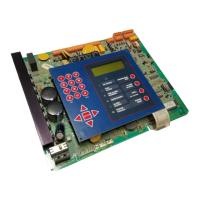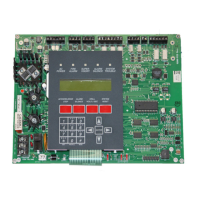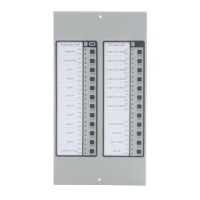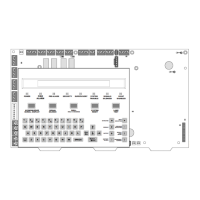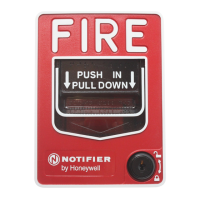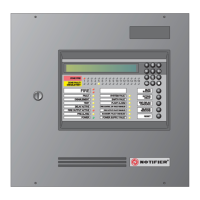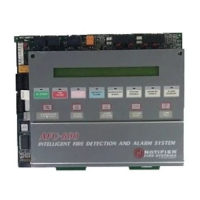
Do you have a question about the Notifier AFC-600 and is the answer not in the manual?
| Brand | Notifier |
|---|---|
| Model | AFC-600 |
| Category | Fire Alarms |
| Language | English |
Details about the AFC-600 Intelligent Fire Panel's features and capabilities.
Key functionalities and operational aspects of the fire alarm system.
Identification of major hardware components of the control panel.
Definition and purpose of the Read Status feature.
Guidance on navigating and using the Read Status section.
Step-by-step guide to accessing the Read Status function.
How to access and output system settings and device statuses.
Description of VROM and VRAM chips for storing messages.
Step-by-step guide for installing memory chips on the AMG-1.
Outline of the manual's sections and appendices.
Explains the meaning of notes, cautions, and warnings used in the manual.
List of related documents that provide additional information.
Keypad shortcuts for accessing program functions quickly.
Guidance on navigating and using the controls section.
Explanation of the function and meaning of each status LED on the panel.
Detailed description of how to use the panel's five main control keys.
Instructions on using the keypad for programming and data entry.
Overview of the topics covered in the control panel operation section.
How the system functions when no alarms or troubles are present.
How the panel indicates and responds to a fire alarm event.
Steps to take when the system indicates a fire alarm condition.
Understanding the codes that identify the type of fire alarm event.
How the panel indicates and responds to a system trouble condition.
Procedures for addressing and clearing system trouble conditions.
How the panel indicates and responds to a security alarm event.
Actions to take when the system detects a security-related event.
How the panel indicates and responds to supervisory signals.
Procedures for handling supervisory signals and tamper conditions.
Understanding the codes that identify the type of supervisory event.
How the panel indicates a pre-alarm warning from a detector.
Actions to take when a pre-alarm condition is detected by a detector.
How the panel behaves and indicates when system points are disabled.
Understanding the behavior of Non-Alarm points like Hazard Alert and Fire Control.
How the panel indicates an active hazard alert from a non-alarm point.
How the panel indicates an active fire control from a non-alarm point.
How the panel indicates an active non-fire point, which has no panel indication.
How the panel indicates and responds to active trouble monitor points.
Procedures for identifying and responding to troubles in output circuits.
How the panel indicates a trouble on a panel circuit.
How the panel indicates a trouble on a control/relay module.
Explanation of system timers like Auto Silence and Alarm Verification.
Specific operational details for waterflow circuits.
Specific operational details for Style 6 wiring.
General introduction to the voice alarm system's capabilities and purpose.
Key features and functionalities of the voice alarm system.
Outline of topics covered within the Voice Alarm Systems section.
Important prerequisites and related documentation before operating the VAS.
Introduction to the AMG-1 and AMG-E's function and capabilities.
Key operational features and indicators of the AMG-1.
Step-by-step instructions for operating the AMG-1.
How to select functions for AMG group operations.
Instructions for recording custom voice messages using VRAM.
How to select tones and messages using AMG-1 DIP switch settings.
Guide to setting the DIP switches on the AMG-1 for configuration.
Introduction to the ATG-2's functionality and paging capabilities.
Key features and indicator lights of the ATG-2.
Step-by-step instructions for operating the ATG-2.
How to select output tones using ATG-2 DIP switch settings.
How to select tones for the primary EVAC channel.
How to select tones for the secondary ALERT channel.
How to configure the ATG-2 for different operating modes.
Introduction to the FFT-7 and FFT-7S telephone units.
Identification of the FFT-7's components and indicators.
Instructions for operating the FFT-7 and FFT-7S telephones.
General introduction to the audio amplifier's role in the voice system.
Key features such as built-in supervision and backup capabilities.
Guide to adjusting the audio output gain for optimal performance.
How to select the backup tone for AA-100 and AA-120 amplifiers.
Diagram identifying components on the AA-30 circuit board.
Explanation of the status indicator LEDs for the AA-30 amplifier.
Diagram identifying components on the AA-100/AA-120 circuit board.
Explanation of the status indicator LEDs for the AA-100/AA-120 amplifiers.
General introduction to special zone operations.
How to configure and operate Releasing Zones for specific functions.
Explanation of the purpose and functionality of Releasing Zones.
Steps to view the current selections for a Releasing Zone.
How Releasing Zones function, including cross-zone configurations.
Introduction to the control panel's timekeeping and holiday functions.
How to view the current settings for time control functions.
How to view the current settings for holiday functions.
Explanation of how time control and holiday functions impact system operations.
Introduction to coding selections for NACs and Panel Circuits.
How to view the selected coding for function F8.
How the system responds to alarms when coding selections are active.
Introduction to Presignal and PAS selection and operation.
Definition and purpose of Presignal and Positive Alarm Sequence features.
How to view the configured Presignal and PAS settings.
How to respond to an alarm with a presignal delay timer active, without PAS.
How to respond to an alarm with both presignal delay and PAS active.
How detector information is displayed and accessed.
How to adjust detector sensitivity and automatic testing features.
Explanation of Type Code supervision, LED control, and alarm verification.
Explanation of how CBE uses Software Zones to link inputs and outputs.
